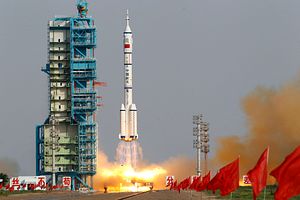Politicians, pundits and headlines have speculated for well over a decade regarding a space race between the United States and China. After a congressional hearing in 2006, Representative Tom DeLay said, “We have a space race going on right now and the American people are totally unaware of all this.” Representative Frank Wolf shared that view, specifically regarding a race to the moon, or back to the moon in the case of the United States. “If China beats us there, we will have lost the space program,” said Wolf. “They are basically, fundamentally in competition with us.”
China space analyst Dean Cheng posited in 2007 that the Chinese were “embarking on a systematic space program the world has not seen since the 1960s and for the first time since the collapse of the Soviet Union, the United States is facing real competition.” TIME ran a headline in 2008 stating, “The New Space Race: China vs US” while others speculated on China taking the competitive lead.
While each statement merits consideration, whatever competition is going on in or regarding space between the United States and China, there are other equally strategic competitive space races going on in Asia as well.
The 1967 Outer Space Treaty, signed by 107 countries including the United States, describes space as a global commons, one open to peaceful use by all countries. But space assets have considerable strategic value in both the civil and military spheres, from the detection of nuclear weapons blasts to the multibillion dollar businesses that rely on positioning and navigation data provided by systems like the U.S. Global Positioning System (GPS), making protection of those assets a national interest potentially worth fighting for. Consequently, space is also increasingly described as a warfighting domain – alongside air, land, sea and cyber – especially by the very “space reliant” United States. Those juxtaposed considerations, the rising number of private, commercial space industries, and the largely dual-use nature of space technology, create an environment ripe for multiple competitions.
When the same dual-use technology is of value to both the civil and military communities, as most space technology is, and it is impossible to tell if military technology is for offensive or defensive purposes, ambiguity reigns. But to the military, capability plus intent equals threat, and with intent unclear, capabilities alone can define threats. Additionally, space prowess conveys considerable prestige that transfers into strategic influence. Consequently, government investments in space both increase regional and even global influence and open potential development opportunities through orbital information technology, and provide considerable military advantages (as first demonstrated during the 1990-91 Gulf War, dubbed the first “space war”) and the need to protect the assets providing those advantages. Therefore it is perhaps not surprising that besides the United States and China, India, Pakistan, Japan, and South Korea are all involved in space races of one kind or another.

































